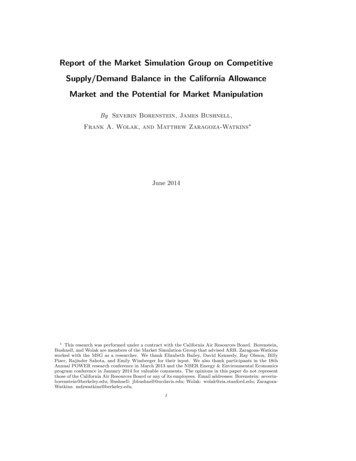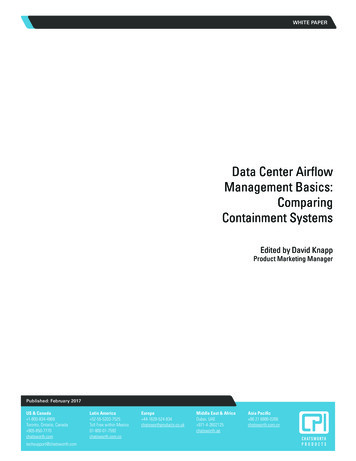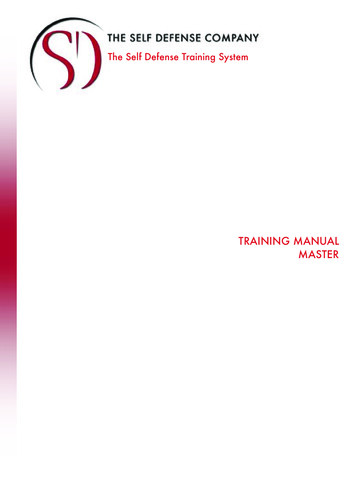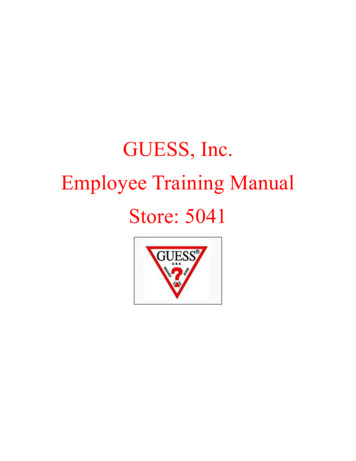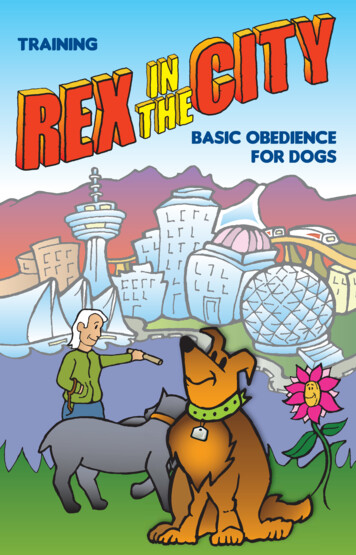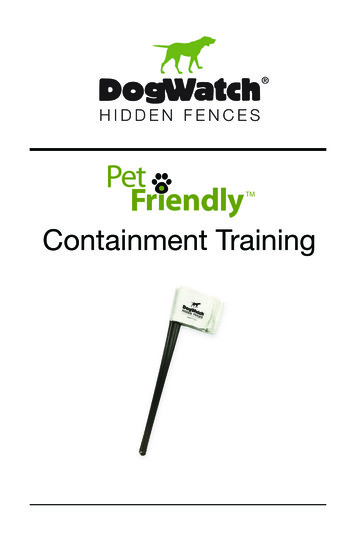
Transcription
Containment Training
4PET-FRIENDLY CONTAINMENT TRAININGThis section provides general guidelines for training your dog to remain within thedesignated boundary of your property. Your DogWatch Dealer will customize thetraining for your dog and teach you the appropriate training approach.Your DogWatch Dealer will install your DogWatch Hidden Fence, set the systemto the appropriate training levels for your dog’s personality, and placeboundary flags around the perimeter of your yard. Afterinstalling the system, your Dealer will prepare you andyour dog for the training process.Your Dog’s Response To StimulationStimulation has been a safe and effective part of dog training for more than 30 years.All dogs respond differently when they feel a mild stimulation. Some dogs maydemonstrate little, if any, reaction, while others may yelp or jump back. Some dogs“freeze”. Do not try to comfort the dog if he receives correction or it will reinforcehis anxiety.Dog Personalities and TraitsKeep in mind that a dog’s personality and traits differ among breeds and individuals.Dogs may not exhibit the same personalities and traits within the same breed.Your DogWatch Dealer will ask you questions about your dog before training begins.A shy or senior dog may require longer Phase 1 sessions, while a gregarious or easyto distract dog may require a short Phase 1, but longer Phase 2 or 3 sessions.The better you know your dog, the easier the training will be for both of you!Creating The Right EnvironmentAttitude and Consistency is Important!1. Keep the training “light”. Use lots of praise. Keep the dog’s spirits high.2. Use high happy tones for praise. Use low tones for negative commands.3. Move around the boundary in the same direction.4. Reinforce the boundary with commands. Use the commands “No!” or“Careful” as you slap or shake the flags.5. Limit training sessions to no more than 20 minutes. Keep training consistent.6. Keep your dog on the leash in the yard for five days.7. If you are training more than one dog, train each dog separately.8. Use naturally occurring distractions such as a neighbor or children.9. Contact your DogWatch Dealer if you have any questions.Remember!Proper training is essential for successful containment. If you have any questionsabout the training phases, especially during the first few weeks, or if you havequestions about your dog’s behavior during his training sessions, please contactyour DogWatch Dealer.2
PET-FRIENDLY CONTAINMENT TRAINING4Safety and Avoidance Zones1. SAFETY ZONE: This is the area where the dog is free to play.2. AVOIDANCE ZONE: The Avoidance Zone is the area between the flags and theboundary wire where there is a signal created by the wire. When your dog crossesinto the signal field, the receiver collar emits an audible warning (or a vibrationwarning if it is a vibration receiver.) If your dog continues to move toward theboundary wire after hearing the warning beeps, he will receive a correction.Boundary WireAvoidanceZoneSafety Zone*Training teaches your dog to stay in his Safe zone.Adjusting the Receiver CollarYour DogWatch Dealer has installed your DogWatch Hidden Fence, set the Transmitterand receiver to the training levels appropriate for your dog’s personality and traits, andhas placed boundary flags around the perimeter of your yard. Your Dealer has alreadybegun your dog’s first day of containment training. Now it is your turn to continue thetraining. Be sure to place the DogWatch receiver collar on your dog’s neck before yougo outside to begin training.1.The collar should be worn snugly on the dog’sneck. This is very important! You should beable to place no more than one thumb widthbetween the contact post and dog’s neck.2.When checking snugness of collar, the dog’sneck should be facing down (sniffing position)as this is where the dog’s neck is the smallest.3.If the collar is too loose, the dog will not receivethe intended correction when he or shewanders into the Avoidance Zone.4.If the collar is too tight, and is not removedperiodically (such as at night), skin irritationmay result in pressure sores.5.DogWatch strongly recommends that the collarbe removed daily and that the dog's neck beperiodically checked for irritation.3Checking the collarContact Postsmust touch skin
4PET-FRIENDLY CONTAINMENT TRAININGPurpose: To teach your dog where the boundary is and how to react to it.1.Only a portion of the yard, the Avoidance Zone,is to be avoided.2.Playtime is very important! Remember toreinforce the Safety Zone and play with yourdog before, during, and after each training session.3.Never throw a ball or toy into the Avoidance Zoneduring training.4.Your DogWatch Dealer will determine the mostappropriate training approach for your dog. It isimportant to work with your Dealer to make sureyou understand the training plan.Play time while training is importantThe following steps describe a general training approach. Your Dealer may modifythe approach described in this manual in order to meet the specific trainingneeds of your dog. There are many successful training approaches that maybe used. If you have questions about containment training, please contact yourDogWatch Dealer for assistance.1PHASE 1 (1-2 days)Audible “Beep” Training (or Vibration)During this phase, the Training Level on the receiver is set to “Audible Only”. Onthis setting, your dog will hear only the audible “beep” tone (or feel the vibrationand will not receive a correction if he enters the Avoidance Zone.1.Put the receiver collar on your dog 20 minutes before training. Your dog’sregular collar should be positioned below the DogWatch collar.2.Clip the green DogWatch training leash on his regular collar.3.Take your dog outside and play with him in the Safety Zone for a few minutes.4.Walk your dog around the perimeter of your yard, keeping inside the SafetyZone and away (about 3 to 4 feet) from the training flags.5.When you finish the walk, approach a training flag. Hold the dog by the leashin one hand and slap or shake a flag with the other, warning the dog firmly (ina low stern voice) “Watch out! or “Careful!” You can also use a friend or familymember to sit in the Avoidance Zone to shake the flag as you approach it.6.Give the leash a firm tug, and quickly retreat into the Safety Zone. Thiscreates a sense of urgency to the retreat. It is not a casual turn. Remember touse of lot of “Good dog!” praise after you’ve retreated into the Safety Zone.7.Now walk your dog around the property allowing him to enter the AvoidanceZone between the two flags.4
PET-FRIENDLY CONTAINMENT TRAINING8.When your dog enters the Avoidance Zone,he will receive an audible “beep” (or vibration)warning. Immediately say, “Watch out!” andquickly tug on the leash and direct him backinto the Safety Zone and praise.9.Repeat several times in different locations(where flags are visible) and watch forhesitation as you approach the flags.Your dog may turn or shake his headwhen he hears the beep (or feels the vibration).Remember: Playtime is very important!4Give a verbal warningat the flags,“No.”Praise and play with your dog in the Safety Zonefor a few minutes. Take your dog inside and removethe receiver collar after about 20 minutes. Train yourdog in this manner for a least two days before moving on to Phase 2.NOTE: In the remainder of the Training section, if you have a receiver equippedwith the Vibration feature: hear the audible “beep” feel the vibration.2PHASE 2 (2-5 days)Introduction to Correction1.Put the DogWatch receiver collar on your dogat least 20 minutes before going outside to train.2.Clip on the green DogWatch training leash andtake your dog outside and play a few minutesin the Safety Zone.Give one tug and warningat the flags,“No.”3.Walk around the complete perimeter, remaining inside the Safety Zone. Pausea few times along the way to slap a flag and say, “No!”4.Your Dealer has set the receiver to the training level appropriate for your dogand has helped you introduce your dog to correction. Phase Two will helpreinforce your dog’s new boundary and the consequences if he crosses thetraining flags. Select a new location to teach your dog today. Allow yourdog to walk into the Avoidance Zone while saying the negative command.When your dog retreats out of the Avoidance Zone after he hears the warning“beep”, praise him for a few minutes in the Safety Zone. Select anotherlocation and repeat the exercise. If your dog does not react to the correction,first check to be sure the contact posts are touching the dog’s skin. If yourdog still does not respond to the correction, contact your Dealer.Remember: Keep the training sessions to no longer than 15-20 minutes, once ortwice a day.5.After training, praise your dog and play with him in the Safety Zone for a fewminutes, bring your dog into the house and remove the receiver collar afterabout 20 minutes.Note: It is important that you do not remove the receiver collar immediatelyfollowing the training as you do not want your dog to associate the collar withthe correction.5
4PET FRIENDLY CONTAINMENT TRAINING3PHASE 3 (2-5 days)Introduction to Distractions1.Put the receiver collar on your dog at least 20 minutes before going outside.2.Clip on the green DogWatch training leash and take your dog outside andplay a few minutes in the Safety Zone.3.Walk around the Safety Zone and have an assistant (friend or familymember) appear outside the Safety Zone at least 10 to 15 feet back fromthe flags. Walk past your assistant without speaking, but remain in theSafety Zone.4.If your dog approaches your assistant and enters the Avoidance Zone, allowyour dog to receive a correction. Say, “Watch out!” and tug him back intothe Safety Zone.5.Let your assistant leave, walk your dog around theperimeter again, and let your assistant appear again.Your assistant can call out the dog’s name, but donot allow your assistant to ask the dog to “Come”.6.If your dog attempts to go over to your assistant,reinforce the flags and say, “No!” Repeat theexercise for no more than a total of 20 minutes.7.If your dog makes no attempt to go over to yourassistant, reinforce the flags, end the exerciseand praise your dog in the Safety Zone.8.Repeat the exercise for 2 to 5 days.Then move to Phase 4.4Ask someone to be a distraction.PHASE 4 (2-5 days)Introduction to Increased Distractions1.Put the receiver collar on your dog at least 20 minutes before going outsideto train.2.Clip on the green DogWatch training leash toyour dog’s regular collar and take him outside.Play a few minutes in the Safety Zone.3.Reinforce the flags.4.Introduce “real life” distractions to your dog.Have a friend drop by or start training when theletter carrier or school bus is scheduled. Takeextra care if you use a vehicle as a distraction.5.Keep the dog on the leash when you first introducethe distraction. If your dog attempts to run past theflags and receives a correction, he should retreat tothe Safety Zone. Praise and play with your dog.6Introduce a distraction.
PET FRIENDLY CONTAINMENT TRAINING1.If your dog retreats to the Safety Zone, drop the leash (but keep it withinreach) and reintroduce the distraction. Praise and Play.2.If your dog is afraid to move, pull him back into the Safety Zone. Continueto train with distractions for 2-5 days4Remember: Play and praise at the end of each training session.5PHASE 5 (2-5 days)Letting Your Dog Off The Leash1.Put the receiver collar on your dog at least 20 minutes before going outside totrain.2.Clip on the green DogWatch training leash to your dog’s regular collar and takehim outside and play a few minutes in the Safety Zone. Remove the trainingleash and let him run freely in the yard. Shake the flags to reinforce where hisboundary is.3.Important: Your dog will expand his comfort level over a period of time. Your dogshould remain about 6 feet away from the flags when he is first let off the leash.Gradually your dog’s safety zone will increase to his individual level of comfort.Remove the flags, every other one, every other day.What To Expect Off The Leash1. Your dog will run toward the flags, see them and stop.2.Your dog will run into the system, hear the “beep” warning and retreat.3.Your dog will run into the system, hear the “beep” warning, receive a correction,and retreat.4.In rare cases, your dog will run through the boundary.- Retrieve the dog. Take off the receiver collar and walk him back into the yard.- Bring the dog into the house and call your DogWatch Dealer. Additional flagtraining or an increase in correction level is necessary. Your DogWatch Dealerwill instruct you over the phone or meet with you and your dog for additionaltraining. Important: Do not punish the dog verbally for making errors. He’s stilllearning!6PHASE 6 (2-5 days)Taking Your Dog Outside The BoundaryYour Dealer will recommend when it is time to take your dog across theboundary for a walk. It is important to be consistent when taking your dog for awalk. Be sure to use your dog’s regular collar and leash and go to and from yourwalk using the same “exit” area. You can also pick up a small dog and carry himover the flagged boundary during the first weeks of training.7
TRAINING TIPS1.Never call your dog to “come” or give a recall command when you areoutside the flag line.2.Never walk your dog through the flags during the training process.3.Always reinforce the retreat concept by shaking the flag while saying“Watch out!” and commanding “back-back-back” when your dog receivesan audible warning or a correction during the training process.4.Adjust the receiver collar, test the battery regularly, keep thecontact posts clean.5.After the training period, your dog may wear the receiver collar during theday, but remove it at night. Check your dog’s neck area and make surethere is no irritation.6.Keep the training consistent: 15 to 20 minutes once or twice a day.7.NEVER throw a stick or toy into the Avoidance Zone.8.ALWAYS maintain a positive attitude when training your dog.DogWatch Inc., 10 Michigan Dr. Natick, MA 01760 (800) 793-3436www.dogwatch.com8
to the appropriate training levels for your dog’s personality, and place boundary flags around the perimeter of your yard. After installing the system, your Dealer will prepare you and your dog for the training process. Your Dog’s Response To Stimulation Stimulation has been a safe and effective part

